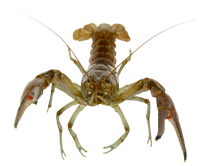Behavioral Neuroscience, lecture on Integration of neural control of Crayfish Escape
Escape - Crayfish
XIII. Integration of Neural Systems in Crayfish Escape Behaviors
A. Sudden-Powerful vs Gradual-Milder environmental stimuli
1. Stereotypic vs Flexible Escape Responses
2. Sudden and Powerful stimuli
a. Behavior depends on direction of the stimulus
i. Rostral vs Caudal
B. A Sudden Strong/Noxious stimulus to the head
1. Mechanosensory hair neural receptor in rostrum/antannae stimulated
a. hair is displaced/bent
b. bending results in physical/chemical opening of Na+ channels
i. depolarization à action potentials ensue
ii. sensory neural signal travels to axon terminals
1) depolarization opens Ca++ channels
2) Ca++ influx releases ACh vesicles from vesicular pool
3) Ca++ causes vesicle binding to active zone
4) Ca++ causes ACh release
2. ACh binds to Nicotinic receptors on many Sensory Interneurons (SI) dendrites
a. Na+ influx into SI neurons à depolarization à action potential
b. SI action potential à axon à terminal at MG dendrite
3. SI action potentials transferred to all MG neurons (1-6 left and right) via electrical synapses
a. Na+ passes through gap junction channels
4. MG action potentials travels to terminals at all MoG motor neurons
a. signal transferred via electrical synapse
5. MoG signals travel to all abdominal segment muscles
a. MoG neuromuscular junctions release ACh
b. ACh binds Nicotinic receptors on the muscle end-plate
c. Na+ rushes in to create end-plate potential (EPP)
d. EPP à T-tubules à sarcoplasmic reticulum à Ca++ release
6. All abdominal muscles contract*
7. *While MGs excite all MoGs - MGs also stimulate Segmental Giants (SGs)
a. via electrical synapses
b. SGs à electrical synapse à all Premotor Interneurons (PmI)
c. SGs + PmIs à electrical synapse à all Fast Flexor (FF) motor neurons
8. All abdominal segment muscles contract
9. Crayfish tail bends very rapidly through all abdominal segments plus the tail
a. once
10. Crayfish moves rapidly in the direction of the tail
C. A Sudden Strong Stimulus to the Tail
1. Tail mechanosensory hairs bend/displaced à Na+ influx
a. ACh released at terminal à Nicotinic Receptors on SI neurons
2. SI neurons electrically activate lateral giant (LG) neurons
3. LGs have 3 main excitatory targets, all stimulated via electrical synapses
a. other LGs
i. longitudinally - from one abdominal segment to the next
ii. laterally - from one hemisegment across to the other
iii. a ladder connective - direct and immediate responses
b. LGs electrically synapses with rostral MoGs (1-3)
i. 6 MoG cells
c. LGs electrically synapse with a pair of segmental giant neurons (SGs)
i. SGs electrically synapse with PmIs and FF motor neurons
ii. all FF are stimulated
1) but not all the muscles that FFs inntervate
d. Caudal FF motor neurons are simultaneously inhibited by SIs
i. caudal FFs (4-6) do not fire
ii. only rostral FFs (1-3) fire
4. Rostral left and right hemisegmental muscle fibers contract
5. the abdomen bends rapidly and powerfully at the segment adjoining the carapace
a. once
6. The crayfish body thrusts upward
D. One upward or reverse thrust from LG or MG activation is due to negative feedback
1. Feedback inhibition
a. MG and LG neurons have recurrent projections
i. recurrent = back to the same neuron
ii. acts via GABA à GABAA at spike-initiating zone (SIZ)
b. MG and LG neurons inhibit sensory neurons
c. MGs/LGs inhibit SIs
d. no more signals can come into stimulate MGs and LGs
2. Feedforward inhibition
a. MGs and LGs also inhibit MoGs
b. after the MoGs have fired once
E. At the end of the thrust, upward or backward, the crayfish often swims away
1. swimming is generated by the parallel NG network
2. thrusting through the water provides broad sensory stimuli
a. gradual, mild stimuli are not potent enough to fire MG or LG neurons
b. NG networks have lower excitation thresholds
3. Sensory neurons stimulate SIs
4. SIs stimulate NGs
5. NGs stimulate PmIs
a. which part of the network stimulated is variable
6. PmIs variably stimulate FFs
a. which PmIs and FFS determine the angle and degree of muscle contraction
7. abdominal hemisegment muscles contract variably
8. Swimming ensues
a. speed and direction determined by which PmIs and FFs are activated
F. Serotonin (5-HT) suppresses the MG/LG escape behaviors
1. Octopamine (OA) enhances MG/LG escape behaviors
2. but... 5-HT can be both stimulatory and inhibitory
3. rapid, brief 5-HT activity on the MG/LG
a. inhibit MG/LG activity
b. lasts for 5-10 min
4. slow, low levels of 5-HT enhance MG/LG activity
a. lasts for 5 h
5. 5-HT may or may not affect electrial synapses
a. 5-HT does affect ionic membrane conductance of MG/LGs
6. Social experience or status alters the effects of 5-HT on MG/LGs
a. dominant or isolated crayfish
i. low [5-HT] enhance transmission à MG/LGs
ii. increases MG/LG responsiveness
iii. acts via 5-HT2 receptors
b. subordinate crayfish
i. 5-HT inhibits transmission to MG/LGs
ii. decreases MG/LG responsiveness
iii. acts via 5-HT1 receptors
G. Escape depends on stimulus strength and social position
